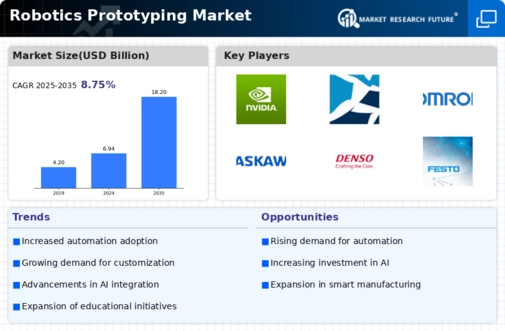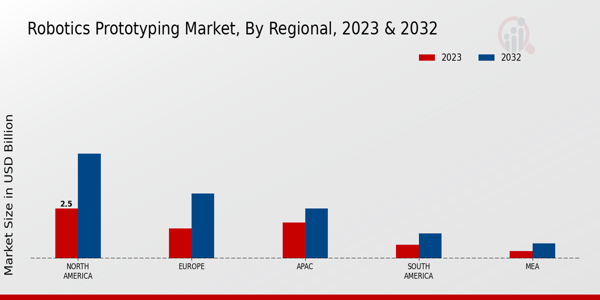Market Growth Projections
The Global Robotics Prototyping Market Industry is poised for substantial growth, with projections indicating a market size of 6.94 USD Billion in 2024 and an anticipated increase to 18.2 USD Billion by 2035. This growth trajectory reflects a compound annual growth rate (CAGR) of 9.15% from 2025 to 2035. Such figures underscore the increasing importance of robotics in various sectors, driven by advancements in technology, rising demand for automation, and expanding applications in emerging markets. The market's evolution is likely to be influenced by ongoing innovations and investments in research and development.
Increased Demand for Automation
The Global Robotics Prototyping Market Industry experiences heightened demand for automation across various sectors, including manufacturing, healthcare, and logistics. As industries seek to enhance efficiency and reduce operational costs, the adoption of robotic solutions becomes imperative. For instance, the manufacturing sector is projected to account for a substantial share of the market, driven by the need for precision and speed in production processes. This trend is expected to contribute to the market's growth, with projections indicating a market size of 6.94 USD Billion in 2024, underscoring the increasing reliance on robotics in industrial applications.
Advancements in Robotics Technology
Technological advancements play a pivotal role in shaping the Global Robotics Prototyping Market Industry. Innovations in artificial intelligence, machine learning, and sensor technologies are enabling the development of more sophisticated robotic systems. These advancements facilitate enhanced capabilities, such as improved navigation, object recognition, and autonomous decision-making. As a result, industries are increasingly investing in prototyping to leverage these technologies. The market is anticipated to grow significantly, with a projected CAGR of 9.15% from 2025 to 2035, reflecting the ongoing evolution of robotics technology and its integration into various applications.
Growing Adoption of Collaborative Robots
The adoption of collaborative robots, or cobots, is transforming the Global Robotics Prototyping Market Industry. These robots are designed to work alongside humans, enhancing productivity while ensuring safety in various work environments. Industries such as manufacturing and healthcare are increasingly integrating cobots into their operations, leading to improved efficiency and reduced labor costs. The trend towards collaborative robotics is indicative of a broader shift towards human-robot collaboration, which is expected to drive market growth. As organizations recognize the benefits of cobots, the demand for prototyping solutions tailored to these systems is likely to increase.
Expansion of Robotics in Emerging Markets
The Global Robotics Prototyping Market Industry is witnessing significant expansion in emerging markets, where economic growth and technological adoption are on the rise. Countries in Asia-Pacific and Latin America are increasingly investing in robotics to enhance their manufacturing capabilities and improve service delivery in sectors such as healthcare and agriculture. This trend is driven by the need for competitive advantage in a globalized economy. As these markets develop, the demand for robotics prototyping solutions is expected to surge, contributing to the overall growth of the industry. The increasing focus on automation in these regions presents a substantial opportunity for market players.
Rising Investment in Research and Development
Investment in research and development is a critical driver for the Global Robotics Prototyping Market Industry. Governments and private entities are allocating substantial resources to foster innovation in robotics. For example, initiatives aimed at developing smart manufacturing solutions and autonomous systems are gaining traction globally. This influx of funding not only accelerates the prototyping process but also enhances the overall quality and functionality of robotic systems. As a result, the market is expected to witness robust growth, with projections indicating a market size of 18.2 USD Billion by 2035, highlighting the importance of R&D in driving industry advancements.





















